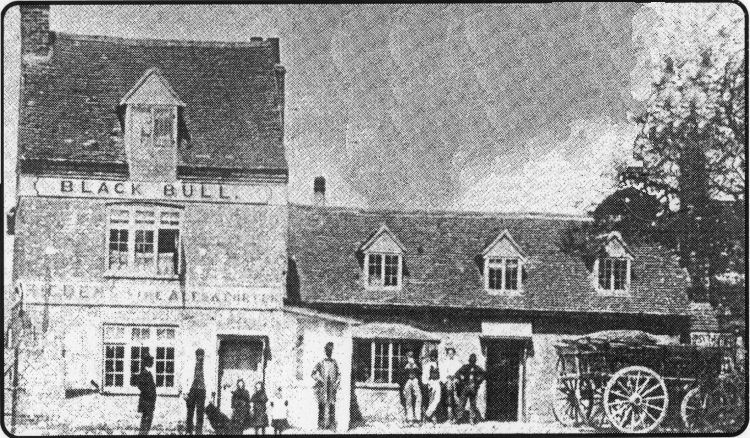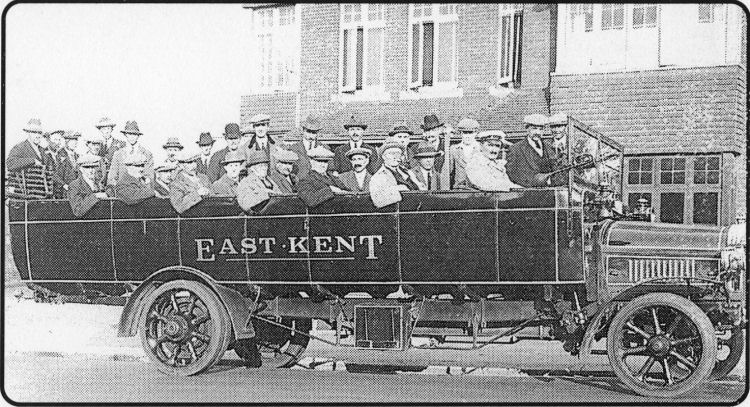
From the Folkestone Herald Published 29 June 2000
Not amused!
LYMINGE reader Mrs E.A. Baker was very interested in the photograph of the
"Black Bull" public house featured in Memories on June 15. It was published in
the new book on the town’s public houses Tales from the Tap Room, by Martin Easdown and Eamonn Rooney.
Mrs Baker says: “My late mother told me the pub at one time belonged to her
maternal grandfather Mr Parkes (or Sparkes.)
“This would have been in the mid 1800s. He had a daughter, my maternal
grandmother, called Amy Esther, who was born in 1866 whilst the family was
at the Black Bull pictured below.

“He also owned donkeys which were used to give rides to amuse children on
Folkestone sands. He stabled them at the cobbled area still existing at the
bottom of the Road of Remembrance.
“My grandmother Amy Esther was engaged to the son of a wealthy family but
she broke it off, eloping with her father’s ‘donkey boy’ and was
consequently disowned by my great-grandfather in 1888.
“He owned several properties in Canterbury Road near the Skew Arches and the
area now known as Dolphins Road, although I believe that in those days it
was known as Cherry Gardens.
“I was once told my great-grandfather was a friend of Mr Aird, who owned
Capel’s "Valiant Sailor" pub.
“Perhaps, amongst your readers, someone may have some anecdotes regarding
the people mentioned.” Mrs Baker lives in Hogben Close.
Another Memories reader a member of Folkestone & District Family History
Society,
tells me she has been trying to help a member of the Braund family and has
shown me three portrait pictures - below - taken at Church Street, Folkestone
by photographer Thomas Matthews Braund in the 1890s.

WHO ARE They: That is the question. Probably members of once prominent
Folkestone families they are shown in studio settings.
They are not thought to be members of the Braund family, but Mrs Janet Few,
of The Braund Society, of 12 Ranelagh Road, Lake, Sandown, Isle of Wight
P036 8NX, would love to hear from any reader who may recognise an ancestor.
Mrs Few is the Braund Society’s membership secretary and, apart from the
address given above, can be contacted and through e-mail
onbraundsociety@fewiow.freeserve.co.uk
Thomas Braund was born in Redruth, Cornwall, in 1863 and began his working
life as a draper. His father, Arscott William Braund, was a chemist.
The Braunds seem to have originated in North Devon and the ancestry of
Thomas can be traced back to 1465.
Some of his relatives moved to Bromley, but only Thomas seems to have been
connected with Folkestone. The original portrait pictures belong to a
distant relative of Thomas.
Derrick Lawson, 72, of Lynwood, Folkestone, who showed me the charabanc
picture above is a former Ashford Railway Worksman. He is descended from Edward Lawson and his wife Alice (nee Punnett),
grandparents, who brought up 15 children at 67 Dover Street.
And he has been telling me of the ghostly activities at the house of what he
describes as a ‘mischievous poltergeist.’
He also tells of the amazing find of no fewer than seven tunnels under the
house when it was demolished in the 1950s, almost certainly connected with
the smuggling activities described in the Folkestone book Smuggling and
Smuggling Days, by an old Folkestone Free trader, written by John English,
first published in the Folkestone Express in 1883 and later reprinted - More
of this another time.

BY COINCIDENCE Derrick Lawson, of Lynwood, Folkestone, a Memories reader,
has just lent me a collection of family photographs which include this
Folkestone Electric Light Company charabanc party outside the Black Bull in
the 1920-30 period. Derrick’s uncle Bill Scowen is seated behind the ‘A’ in
East Kent and his grandfather Joseph Scowen, chief inspector with the
company, is 7th from left in the back row wearing a trilby.
 |
|
1900
MP opens new Cheriton Working Men’s club.
SPECIAL prayers were offered for the recovery of the new Earl
Radnor who was ill in South Africa where he was stationed with British
forces. The Countess of Radnor was en route to South Africa to nurse her
husband, the new Earl, as he recovered from pneumonia following enteric
fever at Bloemfontein. Three privates of the Volunteer Company of the
East Kent Regiment were also reported to be seriously ill in
Bloemfontein. One of the local troops home from South Africa and
recovering after being wounded was Private Boyden of the 3rd King’s
Royal Rifles who had played in goal for Folkestone while stationed at
Shorncliffe. One of the force under Sir George White who were serving in
Ladysmith during a five-month siege, he was shot in the leg and arm and
captured by the Boers but later released. MP Sir Edward Sassoon opened
the new Cheriton Working Men's Institute built in Park Road, Cheriton,
complete with a bath in the basement intended to be for public use, plus
a band practice room. Chairman Mr J.E. Quested referred during the
speeches to the Army's march into Johannesburg after routing the Boer
army and of the freeing of thousands of prisoners.
|
|
1925
Leas Cliff Hall foundations delays plaque unveiling.
DIFFICUITY was being experienced with the foundations for
the new Leas Cliff Hall considerably more reinforced concrete having to
be used owing to the loose, sandy soil. As a result the planned
unveiling of a commemorative plaque by Viscountess Radnor had to be
postponed. Messrs P and A Campbell Ltd proposed to run ten to twelve
steamboat pleasure trips from Folkestone during the summer, hopefully to
Dover, Deal and Hastings although there was some difficulty in getting
consent to use Deal Pier. Southern Railway did not appear to have any
objections, having no coastal trips planned themselves. Swingfield
celebrated the 31st annual festival of the Swingfield Benefit Society,
the work of which covered a large area. The president, the Earl of
Guilford, attended and joined those watching events such as old English
sports in the meadow by the church and attending the annual dinner in
the Recreation Hut, following a church service. Secretary for the whole
31 years, Mr F Gammon reported a very successful year although they
needed some younger members to swell their ranks, the average age of the
300 odd members being about 40. The eighth annual congress of the
National Federation of Laundries was held at the Hotel Metropole,
delegates coming from all over the country.
|
|
1950
Town decides property owners must do repairs.
FOLKESTONE Town councillors, after considering sea defence needs in
the district, recommended that notices be served on some Sandgate
property owners to carry out maintenance and repairs and, failing that,
the Council would do the work and recover the cost from the owners.
Named were Granville Cottage, Granville Parade, 1-8 Devonshire Terrace,
White Lodge, 10 Castle Road and Beach Court. Other work on 4,000 ft of
sea defences from Sea Point eastwards and Sandgate Castle was also
contemplated. A Town Council-planned car park on the Leas, on land
offered by Lord Radnor, would have room for 70 cars. The nearest
existing car park was at Pleydell Gardens with room for 50 cars. Some
objectors said the latter was hardly ever used. Foundation stones of a
new Baptist Church hall were laid at Cheriton, £1,000 having been raised
towards a total of £5,000. The midweek Gazette carried pictures of the
old coach and four fine horses, which, in 1890 operated a service
between Folkestone's West Cliff Hotel, later the Majestic, and
Canterbury, plus a picture of one of the 'crew', Thomas Archer, of Park
Road, Cheriton who was still talking about it 60 years on. The journey
took two hours, with a change of horses at Denton. Old postcards record
the scene.
|
|
1975
Expert warns of danger of a town centre landslip.
AN EXPERT on unstable land subject to landslips, as in
the cases of Sandgate and the Warren, issued a warning about a
potentially frightening connection between these slips and particularly
low spring tides. Alex Todd said nearly ail the major local landslips
occurred at these times. And he claimed that part of Folkestone’s town
centre was as potentially vulnerable as land at Encombe. He was so
worried he called for a engineer’s survey of an area which included West
Terrace, Westcliff Gardens, where the Herald is now located, and parts
of Sandgate Road. He believed no more development should take place
until an expert report had been drawn up. The balance of ground there
was so delicate any substantial increase or decrease in weight of
property on it could spark off an earth movement. He feared a major
disaster pointing to the fact a major landslip occurred 200 years
before. The council's technical services department conceded there were
trouble spots, quoting the example of land movements by the Leas Cliff
Hall in 1970. The same year two maisonettes were left perched on the
edge of a 100 ft drop after a slip at the steps from South Street to Bayle Parade. Solution to the problem, he said, was better drainage of
land. Such a scheme had been demanded in the 60s at Sandgate and a
£40,000 plan drawn up but ultimately It was because residents wouldn’t
contribute 10%.
|
|




